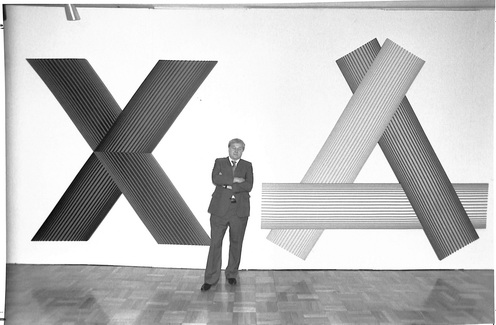 Image from Cleveland Institute of Art's Jessica R. Gund Memorial Library Archives |
Richard Anuszkiewicz | |
| Birth Date: May 23, 1930 |
||
| Death Date: May 19, 2020 Artist Gallery |
||
| Anuszkiewicz was born on May 23, 1930, in Erie, Pennsylvania, to Polish immigrant parents. His mother was a widow with five children when she married his father; it was a late marriage for both of them and Richard was their only child. As a young child, he was precocious in his constant desire to draw on the pads of papers brought to him by his father, a skilled factory worker.
Anuszkiewicz had a happy childhood, since he not only had time to draw at home, but also was given special time for this purpose at the Catholic grade school he attended. In high school his academics were excellent and this allowed him to attend art class three hours each day. He had an inspirational teacher who encouraged him to enter competitions of which he won many, including a four-year scholarship at the Cleveland Institute of Art.
Richard Anuszkiewicz became a leading figure in the art world in 1965 when his work was included in an exhibition titled The Responsive Eye, a survey of optical art at the Museum of Modern Art. This movement became known as Op Art.
In discussing Op Art, Anuszkiewicz points out; “there were two concurrent movements in vogue during that period: Abstract Expressionism and Pop Art which had very strong critical advocates. Well, those advocates helped to bring out the demise of Op Art. What was so hurtful, as far as I was concerned, was that as much as I was given praise and popularity before the movement, once the movement really got on the way I was attacked—and vehemently so. I felt betrayed by my own critics in this country…Also, I feel I’ve explored areas that hadn’t been touched by other artists, including Albers—perceptual ideas that I hope will be lasting…Then there is the matter of optical mixture of color. The Impressionist and Neo-impressionists pioneered the use of color in this fashion, but I think I was the first to explore its possibilities in geometric abstraction with the use of my own color ideas”.
|
||


